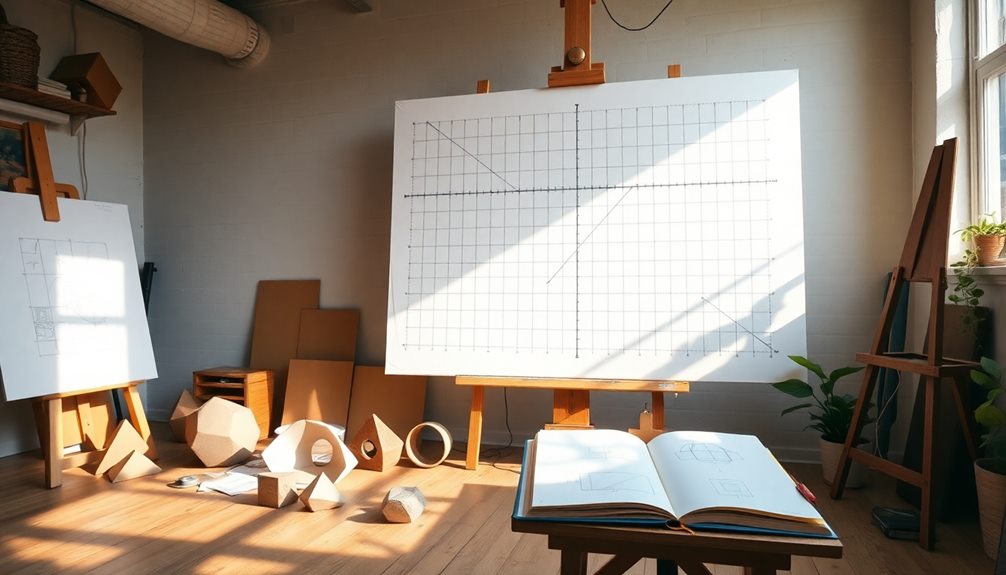To uncover the story in an artwork, analyze its symbols, colors, and visual elements carefully. Look for objects or gestures that carry deeper meanings, and consider how they relate to the scene’s context and setting. Reflect on the artist’s choices, like composition and style, which guide your understanding of the narrative. By exploring these clues and thinking about their connections, you’ll be able to interpret layered messages—if you continue exploring, you’ll discover even more.
Key Takeaways
- Examine the main subjects, gestures, and expressions to understand emotional and narrative cues.
- Identify symbols, objects, colors, and composition techniques that convey deeper meanings.
- Consider the artwork’s historical, cultural, and social context to interpret its message.
- Analyze how visual elements work together to tell a layered story beyond surface details.
- Ask critical questions about the scene’s purpose and symbolism to uncover the underlying narrative.

Have you ever wondered how images can tell stories without a single word? When you look at a piece of narrative art, you’re not just observing a beautiful image; you’re stepping into a visual story that the artist carefully crafted. To truly understand this story, you need to pay attention to the symbolism techniques used throughout the artwork. These are tools artists employ to embed deeper meaning into the visual elements—objects, gestures, colors, and compositions—that might seem simple at first glance. For example, a withered tree could symbolize death or decay, while a blooming flower might represent renewal or hope. Recognizing these symbols allows you to decode layers of meaning that the artist has woven into the scene.
Discover how symbolism reveals hidden stories in art through objects, gestures, and colors.
Equally important is considering the historical context in which the artwork was created. The time period, social climate, cultural influences, and political environment all shape how the story is told. An image from the Renaissance, for example, might include religious symbolism or references to classical mythology, reflecting the era’s values and beliefs. Conversely, a piece from the Romantic period might emphasize emotion and individual experience, using dramatic imagery to evoke feelings. By understanding the historical background, you can grasp why certain symbols appear and what messages the artist aimed to communicate. This context enriches your interpretation, transforming a simple visual into a window into a specific moment in history. Additionally, understanding the symbolism techniques available to artists—such as allegory and iconography—can deepen your appreciation of the layers of meaning embedded in the artwork.
As you analyze the artwork, start by observing the main subjects and their interactions. Notice the gestures and expressions—they often reveal key emotional or narrative cues. Look at the setting: is it a domestic scene, a mythological landscape, or a political event? Each environment carries its own connotations. Pay attention to color choices as well; vibrant hues might symbolize vitality or chaos, while muted tones could suggest somberness or reflection. Developing an understanding of artistic resources and tools like composition and symbolism techniques can also enhance your interpretation. Combine this visual information with your knowledge of symbolism techniques and historical context, and you’ll begin to piece together the story the artist wanted to tell. Remember, every element in the artwork is deliberate, designed to guide you toward understanding its deeper narrative.
Ultimately, uncovering the story behind a work of narrative art requires active engagement. It’s about asking questions—what do these symbols mean? Why did the artist choose this particular scene or style? By honing your skills in recognizing symbolism techniques and considering the historical context, you become a more attentive viewer. This approach allows you to see beyond the surface and appreciate the rich storytelling that visual art offers. With practice, you’ll discover that each artwork is a complex, layered narrative waiting to be uncovered, revealing stories that words alone could never fully express.
Frequently Asked Questions
How Can I Identify Hidden Symbols in Narrative Art?
To identify hidden symbols in narrative art, you should focus on symbolism analysis and iconography decoding. Look closely at details like colors, objects, and figures, and consider their cultural or historical meanings. Question why certain elements stand out or recur, and research their significance. By paying attention to context and symbolism, you’ll uncover deeper layers of meaning, revealing the story the artist intends to tell beneath the visible imagery.
What Techniques Do Artists Use to Tell Stories Visually?
You might think storytelling in art is complex, but artists use clear symbolism techniques and perspective strategies to make it easier. They incorporate symbolic objects, colors, and gestures to convey deeper meanings. Perspective strategies, like foreground and background, guide your eye and create a sense of depth, helping you follow the narrative. By paying attention to these visual cues, you can uncover the story the artist wants to tell.
How Does Cultural Context Influence Narrative Interpretation?
You should recognize that cultural context shapes how you interpret an artwork’s story. Cultural symbolism offers clues about its meaning, while historical influences provide background that deepens your understanding. By considering these elements, you can see beyond the surface and grasp the artist’s message more fully. Your perspective is influenced by the cultural symbols and historical moments embedded in the piece, helping you uncover the story it aims to tell.
Can Abstract Art Effectively Communicate a Story?
Abstract art can effectively communicate a story by leveraging color symbolism and emotional resonance. You’re encouraged to focus on how colors evoke feelings and set moods, guiding your interpretation beyond literal imagery. While it may lack a direct narrative, your understanding deepens as you connect colors and forms to universal themes and personal experiences, allowing you to uncover the story the artist subtly weaves through abstraction.
What Are Common Themes in Narrative Artwork Across History?
You’ll find that common themes in narrative artwork often revolve around love, conflict, and spirituality, showcasing symbolic motifs that tell timeless tales. Recurring themes like heroism, morality, and mortality paint powerful pictures across history. These artworks use symbols and stories to stir emotions and communicate universal truths, making them relatable regardless of era. Recognizing these motifs helps you access the layered stories woven into each piece’s visual narrative.
Conclusion
Now that you know how to spot the story within an artwork, you’re like a detective uncovering hidden secrets. Every brushstroke and detail is a piece of the puzzle waiting to be revealed. Remember, each piece of art is a doorway to a world of stories just waiting for you to step inside. So, keep your eyes open and your mind curious—because the stories in art are like stars, shining brightest when you look a little closer.









